When there are dangerous conditions outside, where does everyone tell you to stay? When you’re asked to help slow the spread of a pandemic, where are you supposed to go? That’s right: home. Your house is supposed to be a safe place, a place you can go even when everywhere else feels a little bit dangerous. When the rest of the world seems busy, hectic, and stressed, home is supposed to provide a place of peace and comfort. However, when there are rats trying to invade your home or already living within your walls, basements, or crawl spaces, peace and comfort are the last things on your mind.
Severe Health Risks
Rats are one of the most dangerous home-invading pests on four or six legs. Significantly larger than house mice, they’ll typically range from six to nine inches long, not including the tail. They’re usually dark grey, black, or brown in color, and very intelligent. During the fall and winter when food becomes scarce outside, rats become very dependent on humans for scraps of food and trash, often raiding easily accessible trash cans in order to find their next meals.
If the trash isn’t providing enough food, they’ll wind up making their way inside to look for more. That’s where the real problems come in. Rats have two qualities that make them dangerous to humans. First of all, they love to spend time in dumpsters, landfills, and sewers, collecting bacteria as they search for food. This bacteria is easily spread all over your house including your frequently touched surfaces and your food preparation areas, putting you at risk of incurring deadly diseases like salmonella, E. coli, and more. Plus, their feces, when left unattended can be very toxic as well, causing allergic reactions in many cases.
Another quality of rats that compounds the health risks is their prolific nature. They are already social pests, typically invading your house in groups of two to four. However, give them a week or two without running them off and you’ll soon have dozens of more rats hiding within your walls. And this doesn’t just increase the health risks. It also increases the levels of damage you’ll incur. Rats have very sharp teeth and an affinity for chewing on the things in your home that you least want to be chewed: walls, linens, insulation, books, magazines, and even electrical wires.
Prevention Techniques
Their ability to chew through almost anything, along with their high intelligence levels, makes rats one of the hardest pests to keep out of your house. They’ll often wait in the yard for the opportune moment (an open garage door or vent) before scurrying into your home undetected. They can also enlarge many of the holes or cracks in the foundation of the house before squeezing through. A few things you can do on your own to limit your chances of infestation include:
- Storing Outdoor Trash Securely: Easily accessible trash is one of the first things that will draw rats onto a property.
- Declutter The Areas In The House That Rats Would Frequent: A cluttered attic or basement provides cover, comfort, and even food for rats in many cases. Open, organized spaces are very intimidating to them.
- Lawn Maintenance: By clearing the debris from your yard, you can limit their hiding places and potential nesting areas. You’ll also want to change up the arrangement of lawn decorations as changes in their surrounding environment will often scare them away.
While these tips can help keep them off of your property, Mother Nature often has her own plans. Once rats get in, you don’t want to waste your time on home remedies while rats are rapidly reproducing at a pace much faster than you can catch them on your own. The most effective and safest way to handle a rat infestation is to contact the professionals at Lonestar Safe Pest. They have experts trained to eliminate infestations and have follow-up plans to keep your home and family safe in the future. Call us today at Lonestar Safe Pest!

